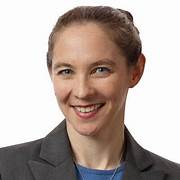
The Americans With Disabilities Act Turns Thirty-Five!
by Elizabeth Wolh, General Counsel // July 29, 2025
By Elizabeth Wohl
Elizabeth Wohl has practiced health law in Vermont for nearly 18 years. She currently serves as General Counsel to the Brattleboro Retreat.
In April of 2017, I woke up one morning with the feeling that my left ear was clogged. There was a strange whooshing sound, and I could no longer make out my children’s high-pitched speech from the other room. After ruling out earwax build up and nasal congestion, I eventually received a diagnosis of “sudden hearing loss of unknown etiology.” The loss of most of my hearing in one ear presents significant difficulties in some circumstances: put me in a noisy restaurant, and I cannot follow the conversation at all. In other contexts, like one-on-one conversations, or well-run meetings, or singing in an opera, it presents no difficulty at all, especially now that I have a hearing aid.
July 26, 2025 marked the 35th anniversary of the Americans with Disabilities Act (ADA). The 1990 ADA recognized that despite significant advancements in access to public spaces and education afforded by the Rehabilitation Act of 1973 and the Individuals with Disabilities Education Act of 1975, many Americans with disabilities faced physical and social barriers to participation and inclusion in basic activities and settings.
With overwhelming bipartisan support, (403 to 9 in the House and 76 to 8 in the Senate) Congress found that “individuals with disabilities continually encounter various forms of discrimination including outright intentional exclusion, the discriminatory effects of architectural, transportation, and communication barriers, overprotective rules and policies, failure to make modification to existing facilities and practices, exclusionary qualification standards and criterial, segregation, and relegation to lesser services, programs, activities, benefits, jobs, or other opportunities.”
The ADA makes it illegal to discriminate against a person who has “a physical or mental impairment that substantially limits one or more major life activities.” The ADA requires employers, public service organizations and public places to recognize the right of disabled people to expect those organizations to remove barriers to their participation. Thus, for example, courthouses must have ramps, elevators, braille signage, and sign language interpreters.
Under the ADA, however, a person is only “disabled,” if the disabling condition lasts more than 6 months or impairs a major life activity. This means that when we use crutches for a broken ankle, or can’t read temporarily because of a concussion, or need a cane because we are recovering from back surgery, or lose most of the hearing in one ear, the ADA does not count us as disabled.
But, nearly all of us experience some sort of disability during our lifetimes. More than 70 million American adults (more than 25% of our population) report having a disability, according to the Centers for Disease Control. Nearly 56% of us become disabled as we approach the end of our lives. And indeed, we don’t think of childhood as a disability, but nearly all toddlers are too short to reach even the drinking fountains designed for wheelchair users.
For some, the strictures of the ADA can seem overwhelming: how can we force new obligations onto old structures? The Disability Pride community, however, responds with joyful creativity. When a barrier exists, we can treat it as a puzzle to be solved, rather than an insurmountable impediment.
The data are clear: when we build public spaces that comport with the ADA, these more inclusive structures benefit all of us. Curb cuts make it easier for parents with strollers to navigate the street. Audio books allow even those with perfect vision to stack wood while still finding out what happens next. Automatic door openers prevent us from spilling our coffee all over our laptops when we are carrying too many things through a door, and using a microphone in a large or crowded room makes it easier for everyone to hear.
As this year’s Disability Pride Month comes to a close, I am re-committing to evaluating when and how I can do a better job advocating for those of us with disabilities, both visible and hidden, and making the environment more accessible for everyone. I hope that you will join me.




